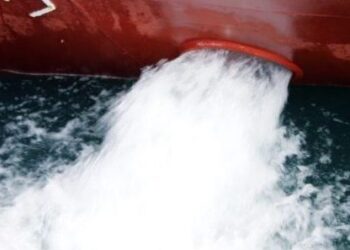Evoqua Water Technologies has re-modelled its SeaCURE® ballast water management system, in order to boost its flow rate performance. Introduced during the Nor-Shipping 2017 exhibition and conference, the next generation is a skid-mounted, plug-in-and-play ballast water treatment system, 76% smaller and 85% lighter than earlier generations of the system. It is also one of the smallest electrochlorination systems on the market.
The main key features of the updated system are the installation and operational simplicity, so that it can fit through standard hatchways and installed by riding crews, reducing pre-installation work and time required during drydock.
Speaking at the introduction, Matt Granitto, business manager for Evoqua’s ballast water business, said: “Without reducing the high flow rate capacity of the existing SeaCURE system, we have dramatically reduced the number of components to create a modular system mounted on a 2m x 1.5m, easy to install skid. It is one the of smallest ballast water management solutions available capable of treating flow rates of up to 6,000m3/h.”
Ian Stentiford, Evoqua Water Technologies’ global vice-president, Electrocatalytic business, informed that the electrochlorination technology can now generate up to six times more output from the electrolyser.
“The advancement has enabled our manufacturing and design partners to standardise the system, developing multiple dose lines capable of treating three ballast lines from a single skid, as well providing marine growth prevention for up to four sea chests. What they have created is a universal enclosure that can be assembled rather than fabricated. Not only is the re-modelled system simple to install, we have been able streamline and reduce the maintenance requirement”, he explained.
As the company explains, the electrochlorination cells used in the SeaCURE® system can be increased or reduced depending on ballast water flow rate and treatment capacity. The cells are self-cleaning, resulting in reduced maintenance time and costs. No chemicals are required. What’s more, the SeaCURE system obviates the need for an additional heat exchanger, even when operating in extreme arctic environments.
Another key feature is the dual functionality of the system. Based on the company’s 50-year experience developing electrochlorination technologies, a SeaCURE BWMS can be configured to also work as a vessel’s marine growth prevention system, protecting against the build-up of biofouling in seawater in critical machinery and cooling systems.
“This means that if the shipowner needs to replace or update an MGPS, then we can layout the SeaCURE system to provide combined marine growth prevention and ballast water treatment capability. This dual functionality can provide a return on investment on the system as shipowners no longer need to invest in two separate systems. I don’t know of any other system that combines ballast water treatment with marine growth prevention,” says Stentiford.
The IMO-approved system is currently in the final stages of USCG testing at Netherlands-based Marine Eco Analytics (MEA-nl). The SeaCURE BWMS is expected to submit for USCG this summer.
Visitors to the Nor-Shipping 2017 exhibition can see the next generation SeaCURE System skid at the Evoqua Water Technologies booth E03-36.






























































